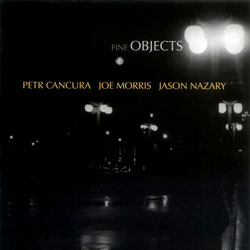
This trio fuses various kinds of inventive qualities in a flux of logic and freedom, the musicians knowledgeably exploiting their capacity of elaborating a given shape — or "thematic structure", as Morris would have it — to increase the inherent improvisational consistency built upon loose-rein contemplation and liberation from the rules, typical assets of free jazz — real free jazz. In this case, though, a level of intuitive organization does function as the very reason for the music to work even more properly.
Saxophonist Cancura, of Czech descent, belong to the class of soloists who don't necessarily need a high degree of ebullience to let a message arrive with concise efficacy. His phrasing is extremely responsive, attributing consequence to the minute detail yet always looking at the completion of the melodic design. Morris, who owns a totally different accent on bass in regard to a celebrated guitar style, frequently acts as a conscious supporter — a tight-lipped coordinator, possibly — whose stout timbre walks towards the forefront when the moment is right, a prescient vision dictating possible harmonic directions if signs are there to be interpreted. Drummer Nazary — who, like Cancura, was a student at New England Conservatory — is an unobtrusive accompanist that — to quote Morris again — "swings like an old tree" when the time comes, a mature talent who respects roles and puts the development of the interplay at the first place. In truth, this is what these artists continuously do.
Fine Objects is a collection which includes standards (well-known or less: Eric Dolphy's "Gazzelloni" to Ornette's "Voice Poetry", plus Larry Clinton's "My Reverie"), compositions by Morris and Cancura, and collectively signed pieces such as the excellent "Rwanda", a riff-based exploration of interlocking flexibility influenced by the reedist's experience in a traditional African group, and "Folk", characterized by a splendid solo played with arco by Morris immediately followed by an invocation on a hypothetical flute (which, instead, is the open end of a clarinet), the whole masterfully interspersed by Nazary's subtle cymbals in what's probably the most suggestive track on offer.
It is difficult to find similar models of respect for certain atmospheres of the past combined with the will to try diverse routes without letting the overall sound be shattered into insignificant shards of theoretical autonomy. In this sense, this is a rewarding album which eschews tiresomeness completely by linking nodal points with straight lines and few embellishments, functional ideas and clever implications intermingled in restrained virtuosity.
Comments and Feedback:



More Recent Reviews, Articles, and Interviews @ The Squid's Ear...


|

